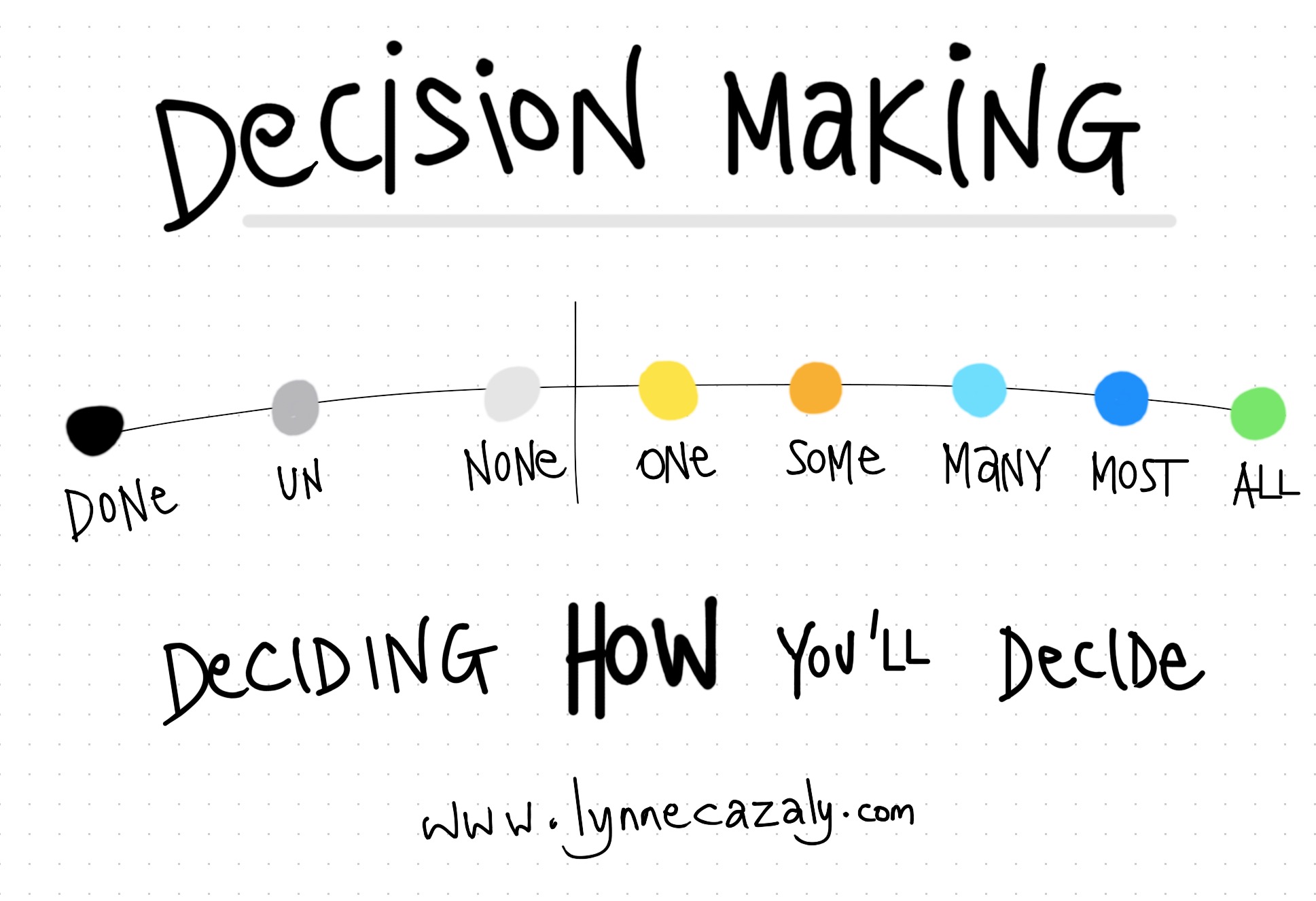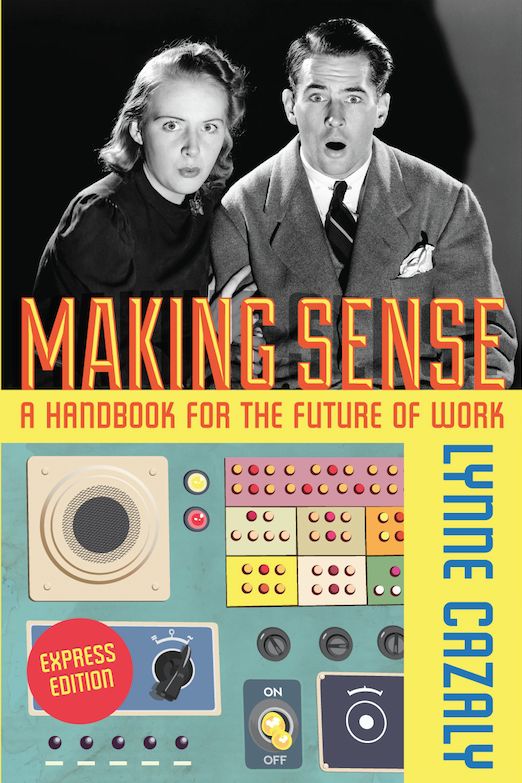 Meetings get a bad rap as being time wasters, energy drainers and demotivators. So when a meeting rocks, it really rocks; it is effective, creative, collaborative, everyone is on song and sh*t gets done.
Meetings get a bad rap as being time wasters, energy drainers and demotivators. So when a meeting rocks, it really rocks; it is effective, creative, collaborative, everyone is on song and sh*t gets done.
For many of us, the success of a meeting or session with the team is based on the outcomes it generates, the decisions made in that time and the end results we're able to walk out of the room with.
Further to my earlier post on why that meeting didn't make a decision, I wanted to delve further into point #3... which is about deciding how you'll make a decision.
Yes, deciding how to decide. It is a thing and it's a thing we can often forget to do.
As a facilitator and creator of the Leader as Facilitator program, I see this all too often: decisions don't get made because we don't quite know HOW we're going to make the decision.
I see it like a spectrum of decision-making in organisations. There's a culture of 'this is how we make decisions around here'.
When you join a new business or team, you may not know what this decision-making culture is until you've experienced it, or tried to make decisions in another way and ended up face planting (aaargh!) or face palming (duh!) or leaving the meeting in deep frustration.
We think or hope the decision-making process is going to be all sweet and nice and collaborative and consensus-like, yet we get surprised or shocked when majority rules and steals all the joy, taking things in a different direction.
Here's what to do before your meeting or session; decide how you'll decide.
Dark Patterns of Decision Making
First to the dark side, to the dark patterns of decision-making: these are Done, Un andNone. They're evil, dark and not pretty but all too common.
Done
Where a decision has already been made prior to a meeting or session and you're there because "consultation". People know they need to consult but they're adopting the decide/defend approach and aren't going to be moved.
Un
When a decision is made, all collaborative-like and everyone's good and a little while after the meeting (be it three minutes, two hours or a couple of weeks) the decision is undone, reversed, reneged or 'reviewed'. Urgh. In political circles, I believe it is called 'the backflip'.
None
No decision is made. Not a thing. Lots of time spent, lots of talk, lots of 'we've got to do this' and 'I have this great idea' and 'How about we...' but nothing actually reaches the conclusion of a decision. This could also be called the 'HUH' decision where you think maybe possibly potentially a decision was made but a little while later it's not clear what the decision or outcome was. I reckon this is still a 'none' for mine.
Moving to Brighter Decision-Making
Let's cross a line here along the spectrum and we see that what happens when we actually DO make a decision; now it's all about HOW that decision is made.
One
Here a singular person - perhaps a project or product owner or stakeholder - who is responsible for the decision, makes the decision. You might have to check-in with them, get them to sign off on it or get their verbal or written 'yes'. It happens all the time; it's the voice or go-ahead from a single sole solitary one individual human. (And with AI and robots pervading our world, they're making decisions for us too!)
Some
A gathering or group, perhaps a sub-committee or other team have been charged with the power to make the decision. Think of an organising committee. They might go off and gather information and then they decide on behalf of others or in consultation with others. Also, this is NOT about a clique or a breakaway or coup who splinter away from the main group. This subgroup has the responsibility and power to decide, as they are.
Many
When you have to put your hand up or vote on anything, this is what's going on. The organisation, project or leader is trying to see how many are across the line on this decision. It's a majority thing, just like an election. Democratic, you all get a say, you all get to stick a coloured dot on the wall, or tick the box or check an answer in a survey or poll.
Most
Here's what a lot of organisations are going for (but perhaps don't quite get there), to get a consensus of sorts. It's where you get to have your say, you get to put forward your view. When there are lots of views to consider it can take awhile. If you're working on a project and you're consulting with stakeholders and need to get most of them 'across the line' or to 'buy-in' to the decision, this is likely what you're going for.
You spend time listening, presenting, helping them understand, you clarify things, and it can go on and on and on. There's nothing wrong with this. It takes time and many people/organisations/leaders are in a panic* about time and simply won't give big decisions the time that's needed to get most people on board.
*I think while MOST is attempted by a lot of organisations, they give up after a while; it takes so long, is quite challenging and chews up the calendar. They might revert to something earlier on the spectrum.
All
Here you get everyone truly onboard. But with complex decisions it's a hard slog. So this is great for straight up simple things that require a decision, but more complex stuff, linger somewhere earlier on the spectrum.
What's the culture of decision-making where you are?
What happens most often?
Which types of decisions get sorted quickly and by which approach?
What other decisions fall elsewhere on this spectrum?
Before you next meeting or the next agenda item, decide what you're going for and how you'll decide. Does everyone need to give a thumbs-up or are you going with something less?
Whatever you do, keep away from the dark patterns of decision-making. They're last-century, old old school and scary.
 Wednesday, December 18, 2019 at 10:14AM
Wednesday, December 18, 2019 at 10:14AM  When the Institute for the Future said sensemaking was something we'd need for 2020 and beyond, I'm sure many people thought 'Huh? What is that, why do I need it?'
When the Institute for the Future said sensemaking was something we'd need for 2020 and beyond, I'm sure many people thought 'Huh? What is that, why do I need it?' 




















